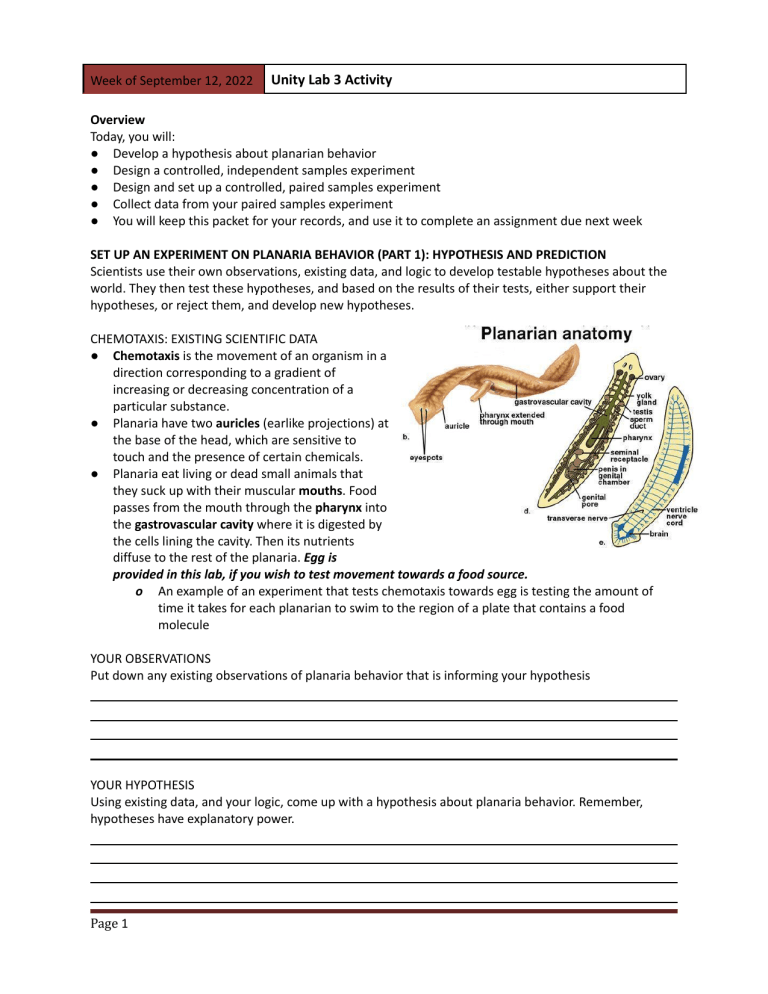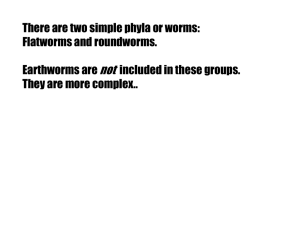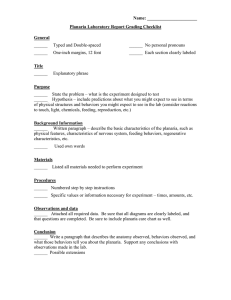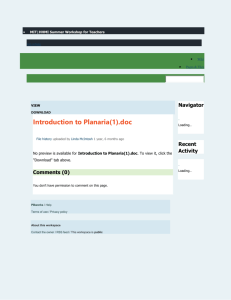
Week of September 12, 2022 Unity Lab 3 Activity Overview Today, you will: ● Develop a hypothesis about planarian behavior ● Design a controlled, independent samples experiment ● Design and set up a controlled, paired samples experiment ● Collect data from your paired samples experiment ● You will keep this packet for your records, and use it to complete an assignment due next week SET UP AN EXPERIMENT ON PLANARIA BEHAVIOR (PART 1): HYPOTHESIS AND PREDICTION Scientists use their own observations, existing data, and logic to develop testable hypotheses about the world. They then test these hypotheses, and based on the results of their tests, either support their hypotheses, or reject them, and develop new hypotheses. CHEMOTAXIS: EXISTING SCIENTIFIC DATA ● Chemotaxis is the movement of an organism in a direction corresponding to a gradient of increasing or decreasing concentration of a particular substance. ● Planaria have two auricles (earlike projections) at the base of the head, which are sensitive to touch and the presence of certain chemicals. ● Planaria eat living or dead small animals that they suck up with their muscular mouths. Food passes from the mouth through the pharynx into the gastrovascular cavity where it is digested by the cells lining the cavity. Then its nutrients diffuse to the rest of the planaria. Egg is provided in this lab, if you wish to test movement towards a food source. o An example of an experiment that tests chemotaxis towards egg is testing the amount of time it takes for each planarian to swim to the region of a plate that contains a food molecule YOUR OBSERVATIONS Put down any existing observations of planaria behavior that is informing your hypothesis YOUR HYPOTHESIS Using existing data, and your logic, come up with a hypothesis about planaria behavior. Remember, hypotheses have explanatory power. Page 1 YOUR PREDICTION Based on your hypothesis, write a prediction. Get this prediction ok’d by your instructor or teaching aide. 2. DESIGN A CONTROLLED, INDEPENDENT SAMPLES EXPERIMENT DEVELOP A PROTOCOL TO TEST YOUR PREDICTION Some things to consider before you develop your protocol. ● This is an experiment, so there has to be a control. ● This is a paired samples experiment. ● An easy way to test planaria movement is by putting a piece of graph paper under the petri dish, and counting the number of squares the planaria swim past in the allotted time. ● You can only observe 1 organism at a time well, so you will most likely do trials of your experiment, 1 organism at a time. ● Planaria put in new environments can act strange until they settle down. Give each planarian 1 minute of acclimation time before you start your data collection. ● You have available to you o Petri dishes o Graph paper o Stop watches o Egg yolk o About 20 planaria ● IMPORTANT: Because of the nature of the assignment you will do this week, you need to collect DISTANCE or TIME based data (for example, how many squares does the planarian pass through to get to a particular square on the grid; or how long does it take a planarian to reach a square or group of squares?) BRIEFLY DESCRIBE YOUR PROTOCOL Get this protocol ok’d by your instructor or teaching aide. 1. 2. 3. 4. 5. 6. 2. Now describe how you would change your protocol to make it an INDEPENDENT SAMPLES EXPERIMENT RECORD DATA FROM YOUR PLANARIA EXPERIMENT (PAIRED SAMPLES) *Data is used in your assignment* Planaria Control Movement Planaria with Egg 1 1 2 2 3 3 4 4 5 5 6 6 7 7 8 8 9 9 10 10 Movement REFERENCES University of California Museum of Paleontology (UCMP) a. Understanding Science. “What is science?” Copyright 2020, Accessed 14 May 2020. Internet. Available from: https://undsci.berkeley.edu/article/whatisscience_01. REVISION HISTORY: RJS 2020; SY 2021 & 2022




